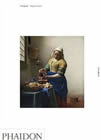The Art of Painting
c. 1662–1668Oil on canvas
120 X 100 cm. (47 1/4 x 39 3/8 in.)
Kunsthistorisches Museum, Vienna
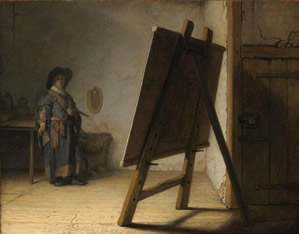
Rembrandt van Rijn
Oil on panel, 24.8 x 31.7 cm.
Museum of Fine Arts, Boston
Vermeer depicts a well-dressed painter working at his easel in a luxuriously appointed room. This artist rests his hand on a maulstick, a tool used in the seventeenth century to provide stability when working while preventing accidental contact with the wet surface of a painting. The painter in Rembrandt’s (1606-69) Artist in His Studio (fig. 1) of around 1629 holds one as well. This work provides an important visual precedent for the portrayal of artists in studios, a theme that first emerged in fifteenth-century depictions of Saint Luke Painting the Virgin Mary. Rembrandt's artist, a possible self-portrait, gazes at an easel supporting a large panel whose surface is hidden from the viewer. Rembrandt used impasto quite skillfully here to make the edges of the panel glow—in effect, subtly intimating the artist’s process of creative thought.
In contrast, Vermeer’s painter is an active one. He is busy applying paint to a laurel wreath on his canvas, simulating the one worn by the oddly attired model in the back of the room (fig. 3). Lamentably, chemical changes to the paint over time have turned many of these laurel leaves blue. The demure model depicted here is no doubt playing a role, what with her laurel wreath and her trumpet, her large book, and the voluminous and somewhat amorphous blue fabric enveloping her upper body. Who is this model supposed to represent? Whose character does she assume with her pose? The answer to this intriguing question can be found in Cesare Ripa’s Iconologia (fig. 2), a popular handbook of the time. Painters and writers of Vermeer’s day who wished to construct allegories consulted the Iconologia; a Dutch edition of this Italian work was published in 1644. Given the thematic specificity of The Art of Painting and his later Allegory of Faith, Vermeer must have been familiar with this text and perhaps even owned it. Ripa describes the muse (creative spirit) of history, Clio, as "a maiden with a laurel garland, who holds a trumpet in her right hand and with the left a book."
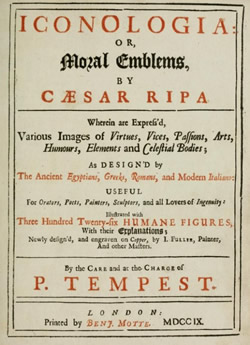
Caesar Ripa1709
The model therefore represents Clio, the muse of history. For this reason, scholars once believed that The Art of Painting embodied Vermeer’s alleged convictions concerning the artistic primacy of history painting. Contemporary art theorists reverenced pictures of this sort, which illustrated episodes from the Bible, mythology, or Classical and medieval history, as the most significant and intellectual type of work an artist was capable of producing. Vermeer began his own career as a history painter, but as we have learned, he abandoned this lofty artistic category altogether by 1656 in favor of making genre paintings, or scenes of everyday life. That Vermeer was no longer executing history paintings belies long-standing views concerning the subject matter of this canvas. After all, why would he extol history painting as the most important category of art when he himself had stopped making history paintings over a decade earlier?
Eric Jan Sluijter has offered a more compelling interpretation of The Art of Painting. He subtly corrects popular misconceptions concerning the significance of Clio, and in so doing argues convincingly that far from exalting history painting, Vermeer’s picture expresses the well-entrenched idea, readily verified in art theory books, that artists accrue to themselves everlasting fame, glory, and honor through their work. This explains why the painter is shown painting Clio’s laurel wreath, a fitting symbol of eternal triumph because this plant’s leaves do not wither. Clio does function here as the muse of history per se; more precisely, she is the muse of history yet to be written. Artists and art theorists were not the only ones who endorsed these notions. Sluijter demonstrates how even the authors of city descriptions, an ever-popular literary genre that nurtured civic pride in the seventeenth century, were aware of them.
Dirck van Bleyswijck, in his "Beschryvinge der Stadt Delft" (Description of the City of Delft) of 1667, listed living Delft painters (including Vermeer), noting that "after they have passed away, when death has snatched their artful brushes from their hands, they will earn even more praise... and although Fame has already made their names illustrious... their names will be handed down to immortality in the books of memory of famous artists by some other eloquent pen according to their merits."
Few paintings in the entire history of art seem as perfect as this one. Vermeer's extraordinary technical mastery, the crystal-clear light which illuminates the scene, the purity of the volumes and the unique psychological distancing of the figures are all characteristics of his work that here reach an extraordinary level of refinement.
Paradoxically, this painting is exceptional within the artist's oeuvre, both in its allegorical subject and for being one of the largest of all his paintings. We do not know what motivated Vermeer to produce it, but his family's efforts to retain it at a period of economic difficulty indicate that it was a picture of which the artist and his descendants were particularly proud.
The composition shows a painter, presumably Vermeer himself; painting a model who poses with a crown of laurel on her head a trumpet in one hand and a book in the other. These accessories refer to fame and its perpetration through writing and would have allowed any contemporary spectator who was well informed in emblems to have identified the woman as Clio, muse of History. The mask which appears on the table is traditionally used as a symbol of imitation and thus of painting. The light hanging above the artist is crowned by a double-headed eagle, symbol of the Hapsburg dynasty which since the sixteenth century had governed the seventeen provinces of the Netherlands that appear in the map on the end wall (and which still governed the southern provinces). As in the majority of interior paintings, it is difficult to know when an element should be read in a symbolic manner. The map and the lamp may, along with Clio, be further references to history or simply reflections of a taste for these objects which contained an element of nostalgia for the days when the Netherlands were united. Since Hultén called attention to the fact that the young woman represents Clio, there has been widespread acceptance of the idea that Vermeer is alluding in this work to the relationship between painting and history: history inspires the artist and, furthermore, according to the prejudice prevailing in artistic circles since Antiquity, is its most important subject-matter, entitling artists to a position of prestige within society.
Some recent authors, particularly Sluijter, have called attention to the fact that it is unlikely that, given the sort of works which he produced throughout his career, Vermeer would make such an affirmation. According to this reading, the painting is demonstration of an allegory of painting's commitment to history, rather than the artist's skills, whose power lies in their capacity to turn the transitory into the eternal, and which the artist used to acquire fame and honours.
Whatever the case, the true protagonist of this painting is its illusionism. Vermeer was brilliantly capable of confusing real and fictive space with a mastery comparable to Bernini or Velázquez. The tapestry which hangs like a curtain to the left of the painting is folded towards the spectator so that we enter into the composition. The curtain covers one corner of the map, a small part of the trumpet and part of the table and chair. With this device, the artist tempts us to stretch out our hand to completely reveal the scene and become physically involved with it. The manipulation of the perspective is also typical of Vermeer, who has situated a vanishing point just in front of the figure of Clio, beneath her right arm, in order to direct our gaze, like that of the artist, towards her (fig. 3).
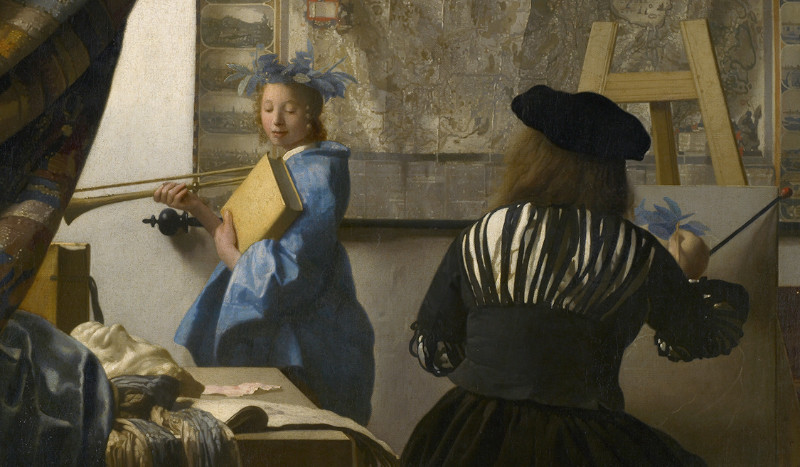
Johannes Vermeer
c. 1662–1668
Oil on canvas
120 x 100 cm.
Kunsthistorisches Museum, Vienna
One of the most important factors which contribute to the success of this work is the contradiction which it sets out between the illusion of reality and its pictorial physicality. While the illusionism is total in many areas of the painting, in others, such as the reflections on the lamp, parts of the tapestry and hair, the pieces of material on the table (fig. 4) and Clio's white neck, the artist leaves the trace of his brushstrokes, calling attention to his manner of painting. The competition between the illusion of reality and the physical evidence of the brushstroke transports us into a different realm, that of Painting. In this space the brushstrokes seem what they are, touches of the brush, but applied within the fictive space of the painting, and not on a canvas which is located various meters in front of the figures.
From the point of view of visual perception, one of the most striking issues in this painting is the spatial relation between the two figures. The painter is located so that his relationship with his surroundings is impossible to specify, given that his feet are resting on dark areas which are difficult to decipher, while the canvas which he is painting is not at an angle and therefore does not help us to understand the place which it occupies. The location of the table is equally ambiguous. The space between the silhouettes of the two lighting, figures becomes an independent one through the definition of the outlines and lighting, emerging from the background of the scene towards the picture surface. Vermeer's skill consists in making us perceive this tension not as a poorly resolved problem but rather as a pictorial issue, a means which allows us to come close to the essence of painting itself.
The Allegory of Painting is such a brilliantly executed work that it is hard for us to remove our eyes from the canvas in order to look at the context in which it was created. However, if we do so, we will appreciate to what extent Vermeer's art can be related to that of his, contemporaries. The interior scene in this painting, the light falling from the left, and its vertical format, the presence of the curtain (fig. 5), the sequence of geometrical forms on the floor and the ceiling which contributes to the creation of the cubic space, are all elements which also find in the work of Dou, Maes, Ter Borch and De Hooch. The theme of the image of the artist is also a common one in painting of the period.
Johannes Vermeer
c. 1662–1668
Oil on canvas, 120 x 100 cm.
Kunsthistorisches Museum, Vienna
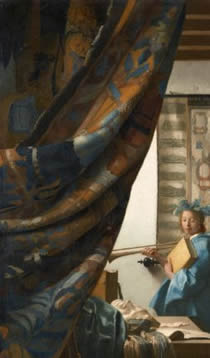
Johannes Vermeer
c. 1662–68
Oil on canvas, 120 x 100 cm.
Kunsthistorisches Museum, Vienna
The Map of the Netherlands

Mariët Westermann
"Vermeer and the Interior Imagination"Vermeer and the Dutch Interior
2003, pp. 232–233
Although paintings of artists in their studios had a rich tradition, The Art of Painting is without significant model or heir, even though Vermeer clearly cribbed some motifs. Most significantly, he followed his peers in having his painter represent a youthful female muse, a geometrically perfected beauty of the ideal proposed by the Girl with the Pearl Earring. Clio's youth is crucial to her effectiveness as the generator of art. In the Netherlandish tradition art had long been conceived as the product of a love affair between the painter and his muse and ultimately Platonic notion that Vermeer's contemporaries tended to cast with sly innuendo. Frans van Mieris, for example, painted his artist enthralled in the presence of a fashionably attired model (fig. 6). Though seen from the back, she looks back at us from the canvas within the painting with a knowing glance, replicated from the background by a maidservant. No unworthy sentiments undermine the virtuous dedication to art shared by muse and painter in Vermeer's allegory. This seriousness may well have kept followers from working directly in its vein. Michael van Musscher's Artist's Studio (fig. 7) of 1690 clearly depends on the painting but neutralizes its unsettling parts. The curtain, map, props, and modeling situation remain, but the painter is no longer turning his back on us and the male model is sitting for his portrait, in a more familiar version of the studio genre. Van Musscher's may be the sort of modern allegory that, in de Lairesse's discriminating vision, does not transcend its historical moment.
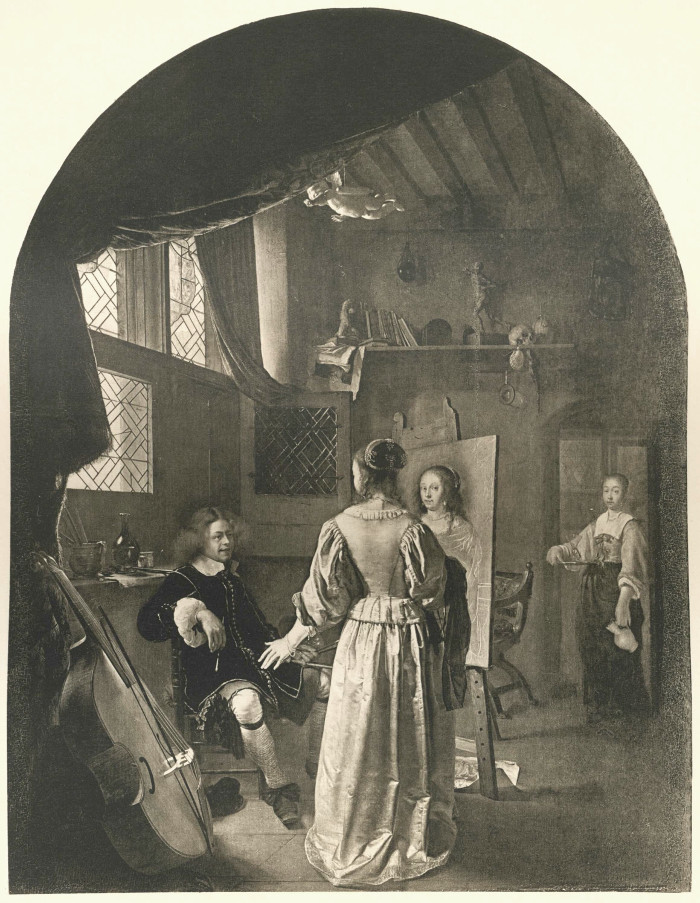
Frans van Mieris
c. 1657
Gemäldegalerie Alte Meister, Dresden
(Lost in WW II)
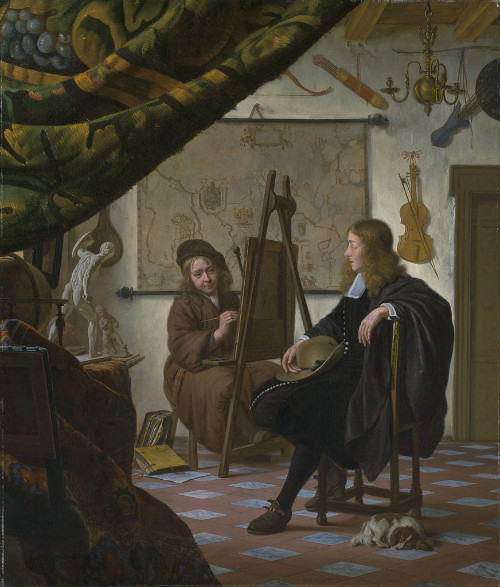
Michiel van Musscher
1690
Oil on canvas
Whereabouts unknown (lost in WWII)
Vermeer appears to have cared enough about The Art of Painting not to sell it. One cannot imagine that Van Ruijven would have turned it down. After Vermeer's death, his wife and mother-in-law tried to protect this one painting from the creditors of his estate, unsuccessfully. The Art of Painting is Vermeer's most explicit statement on his art, and it is characteristic of his art that it cannot be fully described or experienced through iconographic decoding. My discussion (see "Vermeer and the Interior Imagination." in Vermeer and the Dutch Interior, Madrid) of the pictorial and literary sources for Vermeer's interior paintings show the limited usefulness of hunting for textual or artistic precedents. What makes Vermeer's rare but powerful contributions to the history of interior painting interesting is the way in which they articulate thought in pictorial terms.
Philosophers might say that Vermeer was a strongly eidetic painter (from the Greek eidos, mental image, visual thought) in that his way of conceiving his paintings and their mode of communication was distinctly visual rather than literary in origin. In this respect there are uncanny resemblances between the interests of Vermeer and Velázquez, the Spanish master who died about the time of Vermeer's beginnings. Velázquez's tactile renderings of eggs beginning to congeal and water condensing on ceramic jars have striking parallels in Vermeer's The Milkmaid, both in the description of stuffs and in the temporal freezing implied by moving liquids. Like Vermeer, Velázquez's art matured from these early, dazzling displays of virtuosity expended on the low genres to ambitious statements on the nature of the painter's art. It is often said, not wrongly, that The Art of Painting is Vermeer's Las Meninas. These works arose in distinct social contexts and without direct genealogical linkage, as their quite different original destinations and quite different interpretations of the artist's immediate task suggest. Yet the vast distance from the court culture of Madrid to the urban bourgeois milieu of Delft should not obscure congruencies of interest for ambitious painters active most anywhere in seventeenth-century Europe. The Art of Painting and Las Meninas make strong claims for the painter's privileged role in revealing and shaping knowledge in a period newly preoccupied with visual modes of apprehending the world. Their authors thereby occupy seminal positions in a modern history of art that sees art as an activity that must be intellectual and manual in balanced measure.
In 1661 construction of new quarters for the Delft Guild of Saint Luke was begun on the Voldersgracht, directly behind Vermeer's house. The classicizing facade of the new building-which unfortunately no longer exists-was surmounted by a bust of Apelles, the most famous painter of antiquity. The interior was decorated with allegorical representations of Painting, Architecture and Sculpture. In the sections of the ceiling one could admire the seven liberal arts and also an additional eighth, 'Painting', executed by Leonaert Bramer 'out of love for the Guild."
Bramer was one of the officers of the guild in 1661, but in the following year he was succeeded by Vermeer, who was re-elected in 1663 (and served on the board again in 1670 and 1671). The new quarters of the guild must have been still unfinished when Vermeer took office in 1662. Consequently he must have been involved, if not in the planning of the building, at least in its completion-particularly of its decorations, which included the symbolic representation of the arts, above all, the art of painting. It is against the background of this project that we should consider Vermeer's own treatment of The Art of Painting, now in Vienna and often called An Artist in his Studio.
Documents tell us that the picture was in the possession of Vermeer's widow after his death in 1675, and that she did everything in her power to avoid selling it. The fact that Vermeer kept the painting during his lifetime, and the special care that he seems to have taken in its execution, suggest that it enjoyed a privileged place in his oeuvre, and may very well have been his easel for a period of years. Vermeer's painting was of an established type, if we consider not the specific subject, but the general motif a painter depicting a young woman, who appears again in the unfinished painting on his easel. More than a century earlier Maerten van Heemskerck (1498–1574) had painted a Saint Luke Painting the Madonna (fig. 8). With a 'love for the guild' which recalls that of Vermeer's friend Leonaert Bramer, van Heemskerck donated his picture to the Haarlem Guild of Saint Luke. Vermeer may well have known of Heemskerck's work (and of its donation), for it is described in Carel van Mander's famous treatise on Netherlandish painters which was published in 1604. It is even conceivable that Vermeer's painting was also originally intended to be a gift to his guild.
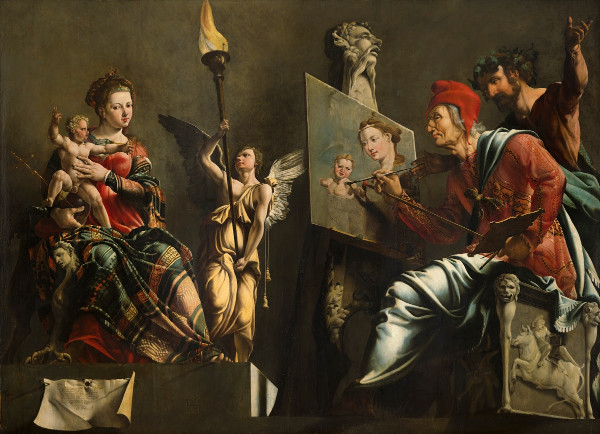
Maarten van Heemskerck
1532
168 x 235 cm.
Frans Hals Museum, Haarlem
The Art of Painting comes late in the day for Dutch painting and late in Vermeer's career. It stands as a kind of summary and assessment of what has been done. The poised yet intense relationship of man and woman, the conjunction of crafted surfaces, the domestic space-this is the stuff of Vermeer's art. But here it all has a paradigmatic status due not only to its historic title but to the formality of its presentation. If this map is presented like a painting, to what notion of painting does it correspond? Vermeer suggests an answer to this question in the form of the word Descriptio prominently written on the upper border of the map just where it extends to the right of the chandelier over the easel. This was one of the most common terms used to designate the mapping enterprise. Mapmakers or publishers were referred to as "world describers" and their maps or atlases as the world described. Though the term was never, as far as I know, applied to a painting, there is good reason to do so. The aim of Dutch painters was to capture on a surface a great range of knowledge and information about the world. They too employed words with their images. Like the mappers, they made additive works that could not be taken in from a single viewing point. Theirs was not a window on the Italian model of art but rather, like a map, a surface on which is laid out an assemblage of the world.
But mapping is not only an analogue for the art of painting. It also suggested certain types of images and so engaged Dutch artists in certain tasks to be done. Vermeer confirms this kind of relationship between maps and pictures. Let us consider his View of Delft: a city is viewed as a profile, laid out on a surface seen across the water from a far shore with boats at anchor and small foreground figures. This was a common scheme invented for engraved topographical city views in the sixteenth century. The View of Delft is an instance, the most brilliant of all, of the transformation from map to paint that the mapping impulse engendered in Dutch art. And some years later in his Art of Painting Vermeer recapitulated the map-to- painting sequence, far the small but carefully executed city views that border the map return his own View of Delft to its source. Vermeer puts the painted city view back into the mapping context from which it had emerged as if in acknowledgment of its nature.

Kees Zandvliet
"Vermeer and the Significance of Cartography in his Time"The Scholarly World of Vermeer
1996, p.76
Another splendid example of a wall map made, as it were, in the service of historiography, is the map of the Seventeen United Provinces depicted in The Art of Painting. When Claes Jansz. Visscher first published it in 1636, the Netherlands had been "disunited" for some time; in fact, an official separation between North and South was imminent. Visscher's historicizing map can be seen as an idealized illustration for the walls of generals and politicians. The map offered them an extensive panorama of military history from the middle of the sixteenth century onwards. Visscher used a whole range of illustrative devices for his survey. The map is flanked by views of centres of power in the Northern and Southern Netherlands: Brussels, Ghent, Antwerp, The Hague, Amsterdam, Dordrecht, and 14 other towns. At the top of the map—but not on the map as depicted by Vermeer—Visscher included 18 equestrian portraits of rulers and commanders-in-chief of the North and the South during the Eighty Years' War, among them the Spanish King Philip II and the Stadhoder William of Orange. Visscher devoted the elaborate cartouche in the top right-hand corner to the theme of 'unity and separation': a female figure personifying the Seventeen United Provinces, holds the coats of arms of North and South in her left and right hands respectively. The theme of military history was touched on by Visscher in the cartouche to the middle left of the map: "De geweldighe cryghen, welcke eero/ts in dese lande n zyn gevoert geweest! ende noch hedensdaegsch gevoert worden, geven voor de gantsche werelt genouchsame getuychnisse van de groote sterckte, vermoghen ende ryckdom der selviger" (The tremendous wars waged in these countries in bygone days, and still waged in these days, bear sufficient witness to the whole wide world of the great strength, power, and wealth of these very countries).
